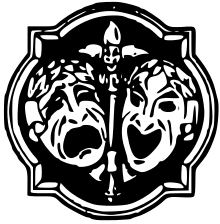Sock and buskin

Comedy and tragedy masks
The sock and buskin are two ancient symbols of comedy and tragedy. In Greek theatre, actors in tragic roles wore a boot called a buskin (Latin cothurnus) that elevated them above the other actors. The actors with comedic roles only wore a thin soled shoe called a sock (Latin soccus).
Melpomene, the muse of tragedy, is often depicted holding the tragic mask and wearing buskins. Thalia, the muse of comedy, is similarly associated with the mask of comedy and comic’s socks. Some people refer to the masks themselves as "Sock and Buskin."[1]
In popular culture
Several theatre organizations are known by the name:
See also
References
- ↑ Charles Mackay (1887). A Glossary of Obscure Words and Phrases in the Writings of Shakspeare and His Contemporaries Traced Etymologically to the Ancient Language of the British People as Spoken Before the Irruption of the Danes and Saxons. S. Low, Marston, Searle, and Rivington. p. 48.
This article is issued from
Wikipedia.
The text is licensed under Creative Commons - Attribution - Sharealike.
Additional terms may apply for the media files.